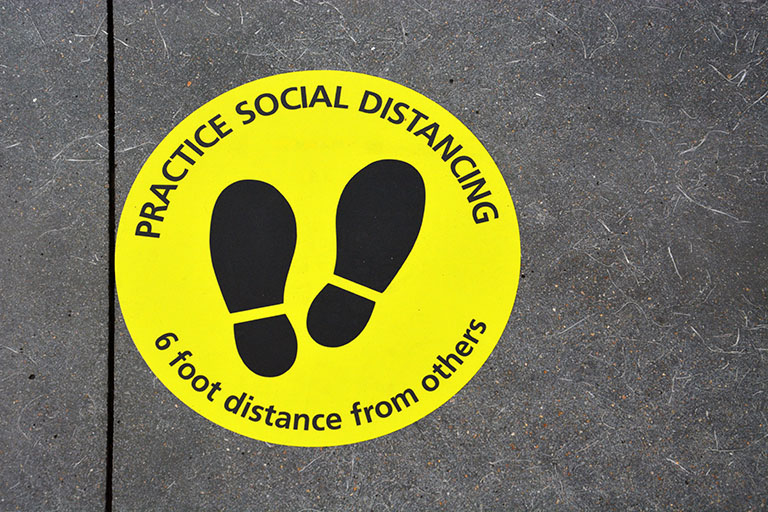Guest Feature
Bobbing and Weaving During the Pandemic
By Chris Gibson, Senior Associate

Real estate Asset Managers wear many hats. Our daily routine can include business planning, property operations, financial analysis, insurance negotiations, marketing, sales and everything in between. Our desk is anywhere and everywhere: the office, airplane, hotel room, property clubhouse and home.
Last March, when our team shifted to “work from home”, we barely flinched and were confident that we’d be back in the office in no time. Reality set in shortly thereafter and we, along with all of our properties, were faced with the new world of lockdowns. Not much fazes an Asset Manager; we like to think we’ve seen pretty much everything under the sun. But, figuring out how to close property offices, clubhouses, pools and gyms – while providing a safe, secure and enjoyable place for our residents to live and play while grappling with a pandemic – was a brand new challenge.
 Communication was fluid. We had daily Zoom calls, shared workbooks in the cloud and visited properties on FaceTime. We created new tools to monitor property and overall portfolio performance in real-time with daily property reporting (on occupancies, rent collections, pricing and more) and an economic sensitivity analysis (showing our “margin of safety” for covering all expenses should rent collections plummet). These tools enabled us to manage each property, each fund and the overall portfolio and to focus our resources where they were needed most. To conserve cash, we paused most deferred maintenance and improvement projects and implemented additional cash controls normally assigned to the property management team to make sure we tightly controlled every nickel going out the door.
Communication was fluid. We had daily Zoom calls, shared workbooks in the cloud and visited properties on FaceTime. We created new tools to monitor property and overall portfolio performance in real-time with daily property reporting (on occupancies, rent collections, pricing and more) and an economic sensitivity analysis (showing our “margin of safety” for covering all expenses should rent collections plummet). These tools enabled us to manage each property, each fund and the overall portfolio and to focus our resources where they were needed most. To conserve cash, we paused most deferred maintenance and improvement projects and implemented additional cash controls normally assigned to the property management team to make sure we tightly controlled every nickel going out the door.
From “day one”, we developed plans for socially-distanced apartment leasing and self-guided apartment tours and produced 3-D virtual tours of unit floorplans and common areas. Prospective tenants concerned about the virus were immediately empowered to tour units online, at their convenience, without having to interface with a leasing agent. Many loved it and these new and flexible tools are here to stay.
With uncertainty about supply chains and new Federal, state and local regulations popping up weekly, we tasked our onsite teams with stocking up on cleaning and PPE supplies and reconfiguring our common areas to comply with social distance regulations. When it came time to start reopening clubhouses, fitness centers and other common area amenities, we worked through preparedness checklists and created reopening plans specific to each property based on federal, state and local guidelines.
To support our front-line workers – the on-site property management teams – we implemented tier-based incentive programs to promote timely rent collections and to reward teams for every incremental dollar of rent collected each month. We provided additional staffing to properties that required extra support for collecting rent, which often included going door-to-door to collect checks. We awarded managers with gift cards for specific achievements and wrote each team handwritten “thank you” cards to show them how much we appreciated their efforts during a time when many felt isolated or were starved of human contact.
To support our residents, we implemented monthly raffles whereby one (or more) household would receive a partial rent credit if they paid rent in-full and on-time. We opened our payment processing systems to all different payment types and absorbed bank fees for credit card payments.
 We also provided our residents with a comprehensive list of rental assistance programs on a regular basis. We worked hard to understand each person’s individual circumstances and listened to every story. If residents were experiencing genuine hardships, we offered extended payment plans and rent deferment options. When necessary, we had our staff take the time to walk residents through the cumbersome rental assistance applications step-by-step, to ensure they were completed accurately and submitted properly. Those who refused to communicate with staff or were simply trying to take advantage of the system, were dealt with quickly. We challenged ourselves to create a variety of unique strategies to get the attention of non-paying, non-communicative residents and offered them win-win options to help them catch up on past-due rent or to move them elsewhere so we could regain possession of the apartment and lease it to a new resident, willing and able to pay rent.
We also provided our residents with a comprehensive list of rental assistance programs on a regular basis. We worked hard to understand each person’s individual circumstances and listened to every story. If residents were experiencing genuine hardships, we offered extended payment plans and rent deferment options. When necessary, we had our staff take the time to walk residents through the cumbersome rental assistance applications step-by-step, to ensure they were completed accurately and submitted properly. Those who refused to communicate with staff or were simply trying to take advantage of the system, were dealt with quickly. We challenged ourselves to create a variety of unique strategies to get the attention of non-paying, non-communicative residents and offered them win-win options to help them catch up on past-due rent or to move them elsewhere so we could regain possession of the apartment and lease it to a new resident, willing and able to pay rent.
The pandemic was a time for each of us to adapt. An Asset Manager must always be able to adapt to succeed and our team did so in spades during the pandemic. The results have been impressive.
Since the beginning of the pandemic, we increased portfolio occupancy by 400 basis points (from 93% to 97%) and our rent collections at 98% have been well above industry benchmarks.
We’ve now resumed most capital improvement projects and we’ve been actively re-opening common areas for our residents in accordance with local regulations.
As we reflect on the past 15 months, we believe that our Asset Management team is smarter and more efficient than ever. We have come to the realization that there is no “new-normal” when it comes to managing properties where people live and that we all must constantly adapt to stay successful.
Chris Gibson is a Senior Associate at Pathfinder Partners, LLC. Prior to joining Pathfinder in 2014, Chris worked for a national commercial real estate management, fiduciary and advisory firm and for a real estate private equity firm. He can be reached at cgibson@pathfinderfunds.com
Share this Article
IN THIS ISSUE
PATHFINDER PARTNERS INCOME FUND, L.P.
A Stablized Multifamily Fund
CHARTING THE COURSE
Great Unconformities in Geology, Economics and Investing
FINDING YOUR PATH
The Value of the Brand
GUEST FEATURE
Bobbing and Weaving During the Pandemic
ZEITGEIST
Sign of the Times
TRAILBLAZING
Juniper Apartments - Sacramento, CA
NOTABLES AND QUOTABLES
Perseverance
